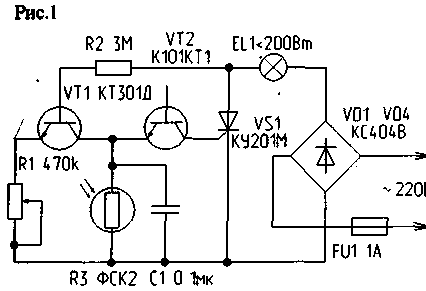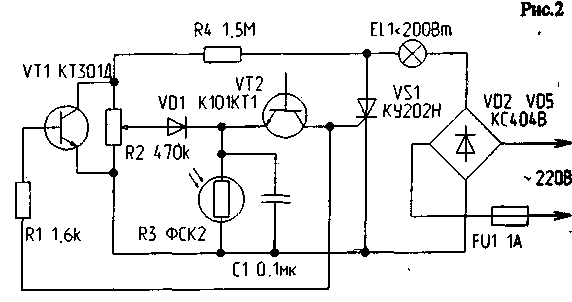Automatic dimmer. Encyclopedia of radio electronics and electrical engineering

Encyclopedia of radio electronics and electrical engineering / Lighting
 Comments on the article
Comments on the article
Regulators (Fig. 1,2) allow you to perform two functions: automatically maintain a given level of illumination, regardless of changes in the level of external illumination, and smoothly adjust the desired level of illumination. The noted properties of the regulators make it possible to use them to maintain constant illumination of corridor areas, for photo printing, setting the thermal (light) mode in industrial and domestic installations (incubators, aquariums, greenhouses, thermo- and photostats, etc. devices).
A light-emitting element (incandescent lamp) with a power of up to 200 W can be included in the thyristor load circuit in direct current (Fig. 1, 2) or in alternating current - in a break in the network wire.

The operation of the thyristor is controlled by a relaxation RC generator made on the avalanche transistor VT2 (K101KT1). At the initial moment of time, the capacitor C1 is charged from a positive half-cycle of voltage taken from the anode of the thyristor VS1 through a resistor R2 and a transistor VT1 (Fig. 1) or resistors R2 and R4 and a diode VD1 (Fig. 2). In parallel with capacitor C1, a potassium sulfide photoresistor of the FSK-2 type is connected, the resistance of which in the dark exceeds 3 MΩ. Thus, if the photoresistor is located in a darkened zone (in the absence of an optical connection between the light emitter EL1 and the photoresistor R3), the latter almost does not bypass capacitor C1.
When the voltage on the capacitor plates exceeds 8 V, an avalanche breakdown of the transistor VT2 occurs and the capacitor is discharged to the control electrode of the thyristor VS1. The thyristor opens for the current half-cycle of the mains voltage and the mains voltage is applied to the incandescent lamp. For each subsequent half-cycle of the mains voltage, the process is repeated. Up to 95% of the input power is released on the lamp, which is typical for all types of thyristor and triac controllers. If the illumination of the photoresistor is increased, its resistance drops to 200 kOhm or less. Since the photoresistance is connected in parallel with the storage capacitor C1 of the generator, its shunting leads to a decrease in the charge rate of the capacitor and a delay in the moment of turning on the thyristor. As a result, the incandescent lamp in each half-cycle begins to turn on with a delay proportional to the level of illumination at the location of the photoresistor. Accordingly, the total illumination is stabilized at a certain (specified) level. The potentiometer R1, included in the emitter circuit of the transistor VT1 (Fig. 1) or R2, connected in parallel with the collector-emitter section of the transistor VT1 (Fig. 2), are designed to set the maximum illumination level and allow you to smoothly adjust the specified level.

If necessary, the device can be converted into a thermostat operating on a similar principle. When mounting the device, the photoresistor should be positioned in such a way that the light from the incandescent lamp does not directly fall on the working area of the photoresistor, because otherwise, the generation of flashes of light is possible, the frequency of which is a phenomenon (optical feedback) that can be used to generate light pulses, determine the distance between the reflective coating and the light emitter / receiver, in various electronic devices.
Author: M. Shustov, Tomsk; Publication: N. Bolshakov, rf.atnn.ru
 See other articles Section Lighting.
See other articles Section Lighting.
 Read and write useful comments on this article.
Read and write useful comments on this article.
<< Back
 Latest news of science and technology, new electronics:
Latest news of science and technology, new electronics:
Air trap for insects
01.05.2024
Agriculture is one of the key sectors of the economy, and pest control is an integral part of this process. A team of scientists from the Indian Council of Agricultural Research-Central Potato Research Institute (ICAR-CPRI), Shimla, has come up with an innovative solution to this problem - a wind-powered insect air trap. This device addresses the shortcomings of traditional pest control methods by providing real-time insect population data. The trap is powered entirely by wind energy, making it an environmentally friendly solution that requires no power. Its unique design allows monitoring of both harmful and beneficial insects, providing a complete overview of the population in any agricultural area. “By assessing target pests at the right time, we can take necessary measures to control both pests and diseases,” says Kapil ... >>
The threat of space debris to the Earth's magnetic field
01.05.2024
More and more often we hear about an increase in the amount of space debris surrounding our planet. However, it is not only active satellites and spacecraft that contribute to this problem, but also debris from old missions. The growing number of satellites launched by companies like SpaceX creates not only opportunities for the development of the Internet, but also serious threats to space security. Experts are now turning their attention to the potential implications for the Earth's magnetic field. Dr. Jonathan McDowell of the Harvard-Smithsonian Center for Astrophysics emphasizes that companies are rapidly deploying satellite constellations, and the number of satellites could grow to 100 in the next decade. The rapid development of these cosmic armadas of satellites can lead to contamination of the Earth's plasma environment with dangerous debris and a threat to the stability of the magnetosphere. Metal debris from used rockets can disrupt the ionosphere and magnetosphere. Both of these systems play a key role in protecting the atmosphere and maintaining ... >>
Solidification of bulk substances
30.04.2024
There are quite a few mysteries in the world of science, and one of them is the strange behavior of bulk materials. They may behave like a solid but suddenly turn into a flowing liquid. This phenomenon has attracted the attention of many researchers, and we may finally be getting closer to solving this mystery. Imagine sand in an hourglass. It usually flows freely, but in some cases its particles begin to get stuck, turning from a liquid to a solid. This transition has important implications for many areas, from drug production to construction. Researchers from the USA have attempted to describe this phenomenon and come closer to understanding it. In the study, the scientists conducted simulations in the laboratory using data from bags of polystyrene beads. They found that the vibrations within these sets had specific frequencies, meaning that only certain types of vibrations could travel through the material. Received ... >>
 Random news from the Archive Random news from the Archive CIA considers using microwaves and irons for spying
28.03.2012
CIA director David Petraeus for the first time publicly appreciated the exceptional usefulness of new "household" technologies for espionage.
More and more personal and household devices are connected to the Internet: from TVs to car navigation systems. Recently, the head of the largest intelligence agency in the world, David Petraeus, called new technologies that are widely distributed among ordinary citizens "transformational" and have a huge impact on the work of intelligence officers.
David Petraeus said the new online devices are a treasure trove of data for his department. If earlier spies had to engage in dangerous surveillance and try to put listening devices in all places where there is a person of interest to intelligence, today the situation has changed dramatically. With the advent of "smart homes", geo-referenced data (from photos on social networks, smartphones, navigators, etc.), the CIA can receive a lot of useful data in real time: from a person's location to secret filming through a cell phone or laptop camera.
In the future, intelligence capabilities in this area will grow even more, as remote control and monitoring systems, sensor networks, RFID chips, data servers built into refrigerators and even food processors, etc. are expected to be widespread. All this electronics has a large computing power and can perform the "side" tasks that scouts need. Petraeus pins great hopes on cloud services, supercomputers and quantum computers that will be able to process a huge amount of information that is distributed by a modern "advanced" user.
Petraeus stressed that consumer devices are "changing the way we think about privacy, personal information and secrecy." Thus, the CIA has many legal restrictions regarding spying on foreign and especially American citizens. But collecting data like geolocation, internet statistics, etc. is a "grey zone" where one can act freely. Hardware manufacturers collect a huge amount of data, and it is very easy for the government to track people through common devices like a phone or a PlayStation.
|
 Other interesting news:
Other interesting news:
▪ People become more merciful as they age
▪ LG ltraGear 48GQ900 OLED Gaming Monitor
▪ Created a device to simulate odors in computer games
▪ Global flood delayed
▪ solar phone
 News feed of science and technology, new electronics
News feed of science and technology, new electronics
 Interesting materials of the Free Technical Library:
Interesting materials of the Free Technical Library:
▪ section of the site Mobile communications. Article selection
▪ article Interference. History and essence of scientific discovery
▪ article What is oceanography? Detailed answer
▪ Article Partridge Grass. Legends, cultivation, methods of application
▪ article Signal flashlight on solar cells. Encyclopedia of radio electronics and electrical engineering
▪ article Laboratory power supply, 220/3-24 volts 2,7 amps. Encyclopedia of radio electronics and electrical engineering
 Leave your comment on this article:
Leave your comment on this article:
 All languages of this page
All languages of this page
Home page | Library | Articles | Website map | Site Reviews

www.diagram.com.ua
2000-2024







 Arabic
Arabic Bengali
Bengali Chinese
Chinese English
English French
French German
German Hebrew
Hebrew Hindi
Hindi Italian
Italian Japanese
Japanese Korean
Korean Malay
Malay Polish
Polish Portuguese
Portuguese Spanish
Spanish Turkish
Turkish Ukrainian
Ukrainian Vietnamese
Vietnamese


 Leave your comment on this article:
Leave your comment on this article: